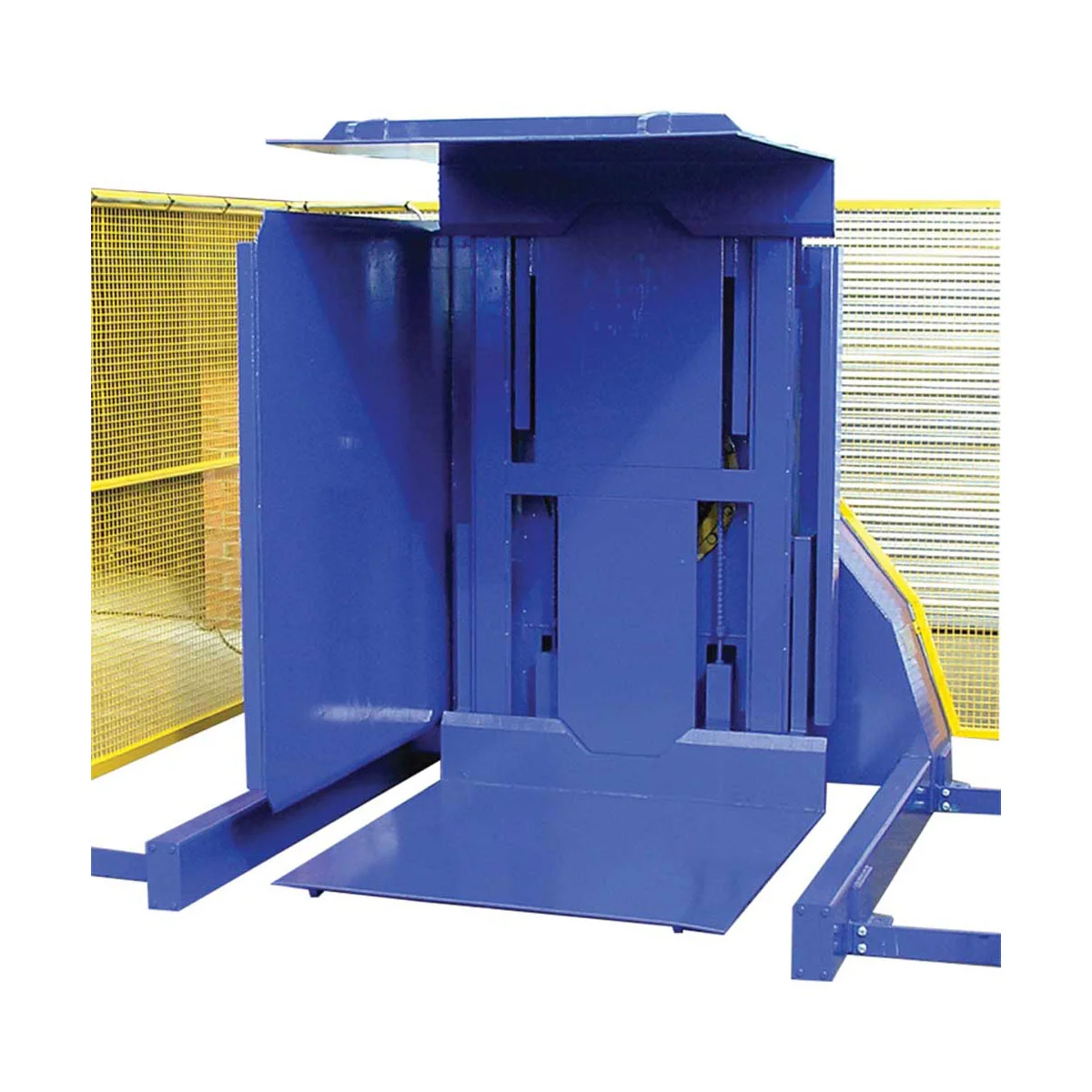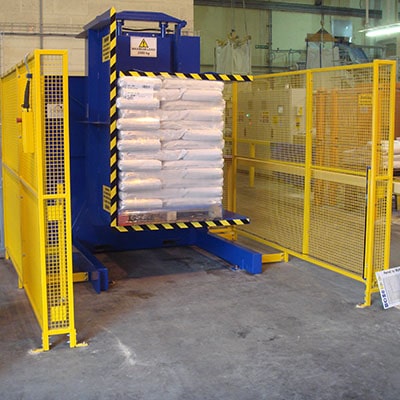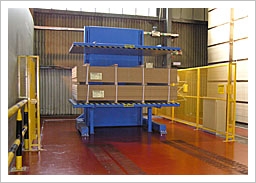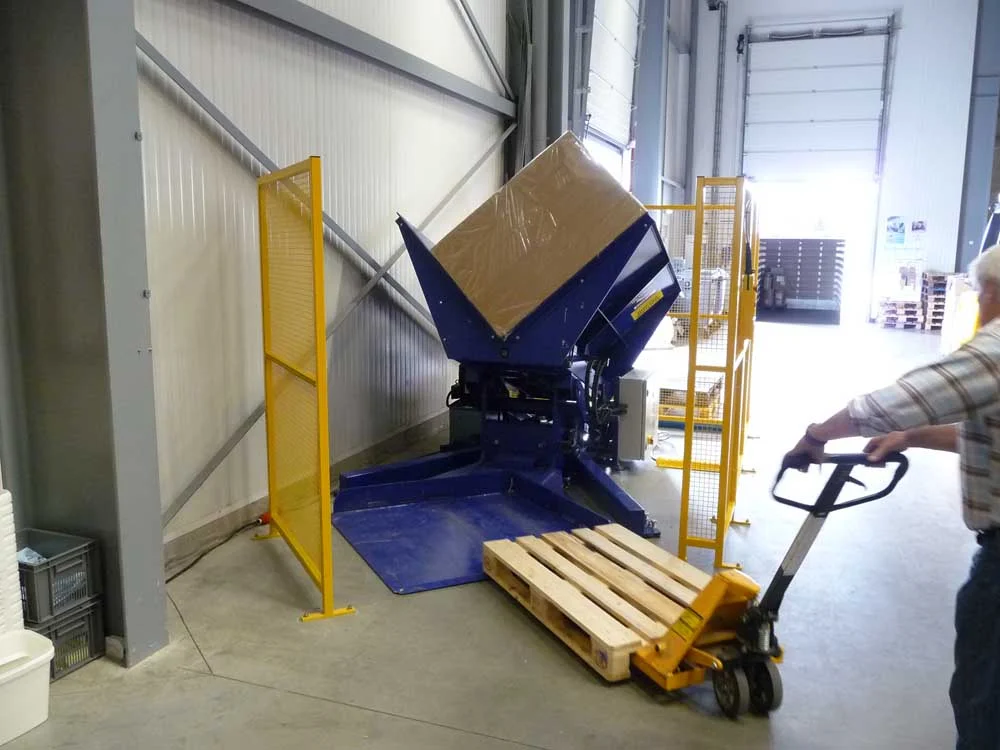Is Your Turkey Factory Struggling with Cold Chain Efficiency and Hygiene Standards? Try a Pallet Changing Machine
Running a food processing facility, especially in a competitive market like Turkey's, presents unique challenges. You are constantly under pressure to maintain the highest hygiene standards and ensure the integrity of your cold chain. A single misstep can be costly. These pressures often create bottlenecks, slow down your operations, and eat into your profits. You know there has to be a better way to handle materials than the slow, risky manual methods you're currently using. What if you could solve these issues with one strategic investment that streamlines your entire process?
Yes, a pallet changing machine can be a game-changing solution for a turkey factory facing cold chain and hygiene challenges. This equipment automates the transfer of your products from one pallet to another, such as moving them from an external wooden pallet to a sanitized, in-house plastic pallet. This single action drastically reduces manual handling, minimizes the risk of contamination, and speeds up your logistics. It creates a controlled, efficient, and hygienic bridge between your production and shipping areas, directly addressing your biggest operational pain points.

This technology is more than just a piece of equipment. It represents a fundamental shift in how you approach material handling. It's about building a smarter, safer, and more profitable operation from the ground up. I've spent my career in industrial automation, and I've seen firsthand how a single, well-placed machine can transform an entire workflow. Let's dig deeper into the specific problems a pallet changer solves and see how it can directly benefit your factory.
How Can a Pallet Changer Fortify Your Cold Chain Integrity?
In the food industry, temperature is everything. For your turkey products, every moment they spend outside a controlled, refrigerated environment is a risk. Manual pallet transfers are notoriously slow. Workers need to de-stack, move, and re-stack boxes, a process that can take many minutes. During this time, your carefully chilled products are exposed to ambient temperatures, putting the cold chain in jeopardy. This is a constant worry that keeps plant managers up at night.
A pallet changer strengthens your cold chain by making the transfer process incredibly fast. Instead of minutes of manual labor, an automated pallet changer can swap a full pallet of goods in under 60 seconds. This massive reduction in transfer time means your products experience minimal temperature fluctuation. The system keeps the pallet load contained and moves it swiftly, ensuring it stays within the safe temperature zone required to maintain quality and comply with food safety regulations.

The Critical Link Between Time and Temperature
The core principle of the cold chain is minimizing the time a product spends above its recommended temperature. This is often called the Time-Temperature Tolerance (TTT). For frozen or chilled turkey, this tolerance is very low. A small increase in temperature can begin to affect product quality, safety, and shelf life. Manual processes are the weakest link in this chain. They are inconsistent. The time it takes can vary depending on the workers on shift, their fatigue level, and the specific load.
A pallet changing machine removes this variability. It performs the exact same operation, in the exact same amount of time, every single time. This predictability is invaluable for quality control and for planning your logistics. You can precisely calculate how long a pallet will be in the transfer zone, which is critical for your HACCP (Hazard Analysis and Critical Control Points) plans. The machine essentially turns a high-risk variable into a controlled, low-risk constant in your operation. This is a level of control that manual labor can simply never achieve.
Analyzing the Impact: Manual vs. Automated
Let's look at a direct comparison. Imagine a full pallet of chilled turkey products needs to be moved from a wooden shipping pallet to an in-house plastic one at the entrance to your processing hall.
| Feature | Manual Pallet Transfer | Automated Pallet Changer |
|---|---|---|
| Average Time | 5-10 minutes | 45-60 seconds |
| Temperature Exposure | High and variable | Minimal and consistent |
| Labor Required | 2 workers | 1 operator (monitoring) |
| Risk of Product Damage | Moderate (dropping boxes) | Very Low |
| Consistency | Low | High |
As the table shows, the benefits go far beyond just speed. An automated system reduces the potential for human error, which can lead to damaged packaging and spoiled products. It also frees up your workers to focus on more value-added tasks instead of repetitive, physically demanding labor. By fortifying this critical transfer point, you strengthen the entire cold chain from receiving to final dispatch.
What Are the Direct Hygiene Benefits of Automating Pallet Transfers?
Every food factory battles a hidden enemy: cross-contamination. One of the biggest culprits is the humble wooden pallet. It arrives from outside your facility, carrying dust, moisture, bacteria, and pests. When these pallets enter your clean production zones, they bring all those contaminants with them. You can have the most sterile processing equipment in the world, but if the foundation your product sits on is dirty, your hygiene efforts are compromised. This can lead to failed audits, product recalls, and severe damage to your brand's reputation.
A pallet changer acts as a powerful gatekeeper, creating a strict physical and hygienic separation between "outside" and "inside" zones. It allows you to receive goods on standard wooden pallets and, in one smooth, automated motion, transfer the product load onto sanitized, non-porous plastic or aluminum pallets. The contaminated wooden pallet never crosses the line into your clean area. This simple but effective strategy eliminates one of the most significant sources of cross-contamination in any food processing plant.

Establishing a "Hygienic Airlock"
Think of a pallet changer as a "hygienic airlock" for your materials. In my early days as an engineer, I visited countless factories. The best ones always had clear lines of demarcation. They had "red zones" (dirty) and "green zones" (clean), and strict protocols for moving between them. A pallet changer automates this "red-to-green" transition for your products.
This machine is typically installed right at the boundary of a high-care area. Here’s how it works:
- A forklift brings a load on a wooden pallet to the "dirty" side of the machine.
- The machine clamps the load securely from the sides or top.
- It then inverts or pushes the load, smoothly transferring it onto a clean, sanitized pallet waiting on the "clean" side.
- The empty wooden pallet is ejected on the dirty side, and the product, now on a clean pallet, is ready to proceed into the production environment.
This process is touch-free from a human perspective. It removes the risk of a worker handling a dirty pallet and then touching the product or a clean surface. It's a simple, elegant, and highly effective engineering solution to a complex hygiene problem.
Meeting and Exceeding Compliance Standards
For any Turkish exporter, meeting international food safety standards is not optional. Certifications like BRCGS (Brand Reputation Compliance Global Standards) and IFS (International Featured Standards) are essential for market access. These standards have very specific requirements about managing foreign body contamination and maintaining hygienic zones.
A pallet changer helps you directly meet these requirements.
| Standard Clause (Example) | Requirement | How a Pallet Changer Helps |
|---|---|---|
| BRCGS Food Safety 4.9.2 | "Procedures shall be in place to minimize the risk of foreign-body contamination from pallets and other raw material transport items." | Automates the removal of external pallets (a primary source of wood splinters, nails, and dirt) before they enter production. |
| IFS Food 4.9.8.1 | "A risk assessment shall be conducted for all incoming materials... to identify potential hazards, including microbiological, chemical, and physical contamination." | The system is a critical control point (CCP) that mitigates the physical and microbiological hazards associated with external pallets. |
| HACCP Principle 2 | Identify Critical Control Points (CCPs). | The pallet transfer point becomes a clearly defined and easily monitored CCP to control contamination hazards. |
By installing a pallet changer, you are not just improving your process; you are building auditable proof of your commitment to food safety. When an auditor sees this system in place, it sends a powerful message that you take hygiene seriously and have invested in robust, preventative controls.
Can a Pallet Changer Actually Improve Your Factory's Throughput and Lower Costs?
Every factory owner is focused on the bottom line. You might see a pallet changer as a significant capital expense. It's natural to wonder if the investment will truly pay off. You're dealing with slow production lines, high labor costs for manual handling, and the constant financial risk of product damage or workplace accidents. The bottlenecks at your shipping and receiving docks are costing you time and money every single day.
Yes, a pallet changer delivers a strong return on investment by directly boosting throughput and cutting multiple operational costs. It transforms a slow, manual bottleneck into a fast, automated process, allowing you to move more product in less time. This efficiency gain is paired with significant cost savings from reduced labor needs, less product damage, and a safer work environment, which can lower insurance premiums. It’s an investment in efficiency that pays dividends across your entire operation.

A Practical Look at Throughput and ROI
Let's break down the numbers. The real value of automation isn't just about speed; it's about predictable, continuous flow. This is what we call throughput.
I remember a client in the steel wire business who had a similar problem. Their entire production line could produce 20 coils per hour, but the manual packing and handling team could only manage 15. That 5-coil-per-hour gap was pure lost profit. Automating that final step unlocked the full potential of their entire line. The same principle applies here.
Let’s compare the throughput:
- Manual Team (2 workers): Can transfer maybe 10-12 pallets per hour. This rate drops as fatigue sets in.
- Pallet Changer (1 operator): Can consistently transfer 40-60 pallets per hour, all day long.
This four-to-five-fold increase in speed at a critical point has a ripple effect. It means trucks are loaded faster, your finished goods don't pile up waiting for transfer, and your production line can run at its true capacity. To calculate the Return on Investment (ROI), you need to consider more than just the machine's price. You must factor in the value of this new capacity and the direct cost savings.
The Hidden Cost-Saving Benefits
The financial benefits of a pallet changer go far beyond just labor. Many of these savings are often overlooked in initial calculations but have a huge impact on your overall operational costs.
| Cost-Saving Area | Manual Process Cost | Automated Process Benefit |
|---|---|---|
| Product Damage | High risk of dropped boxes or pierced packaging during manual restacking. This leads to waste and rework. | The machine's gentle, controlled clamping and movement virtually eliminate handling-related product damage. |
| Workplace Safety | Repetitive lifting of heavy loads is a leading cause of back injuries and other musculoskeletal disorders. This leads to lost time and higher insurance costs. | Automating the heavy lifting creates a safer work environment, reducing injuries and potential liabilities. |
| Labor Allocation | Skilled workers are tied up doing low-value, physically demanding tasks. | Workers can be reassigned to more complex, value-added roles like quality control, machine operation, or inventory management. |
| Pallet Costs | You may be paying a premium for high-quality or heat-treated wooden pallets for export. | You can use cheap, standard wooden pallets for incoming freight and invest in a durable, reusable pool of plastic pallets for internal use. |
When you add up all these benefits—higher throughput, lower labor costs, less waste, improved safety, and smarter pallet management—the financial case for a pallet changer becomes very clear. It's an investment that systematically removes inefficiency and risk from your business.
My Insights: How Do These Principles Apply Beyond Food Processing, Even in a Steel Mill?
You might be reading this and thinking, "Vincent, this is interesting, but I run a steel mill in Mexico. What does a Turkish turkey factory have to do with me?" It's a fair question. On the surface, the industries look completely different. But after more than two decades in this business, from my start on the factory floor to building my own company, I've learned one crucial lesson: the fundamental principles of efficiency, safety, and smart material handling are universal.
The core logic behind using a pallet changer in a food plant applies directly to the challenges you face in a steel mill. The goal is always to create controlled transitions, automate bottlenecks, and protect your product and people. Whether you are preventing bacterial contamination or preventing damage to a high-value steel coil, the strategy is the same. It's about isolating different operational environments and ensuring materials flow through them as efficiently and safely as possible.

From Food Hygiene to Industrial Product Integrity
Let's reframe the problem. A food factory uses a pallet changer to create a "hygienic barrier." They want to keep "dirty" outside pallets away from their "clean" production zone.
Now, think about your steel mill. You receive components or move finished products on various types of pallets or skids. An incoming wooden pallet might have nails or splinters that could scratch a finely finished steel sheet. A standard warehouse pallet might not be strong enough to handle the immense weight of a steel coil, leading to risk of collapse. In your world, the "hygienic barrier" becomes a "product integrity barrier." You need to transfer your valuable steel products from a generic transport pallet to a specialized, heavy-duty, or specially-shaped in-house skid for safe handling and storage. This is the exact same principle, just applied to a different product. The goal is to control the "environment" the product sits on to protect its value.
A Universal Problem: The Bottleneck
The biggest parallel is the problem of the bottleneck. In the turkey factory, the bottleneck is the slow, manual transfer of pallets that holds up the shipping dock. In my own experience, I saw a steel wire factory nearly crippled by a similar issue. The drawing machines were running perfectly, but the final stage—where workers manually banded and moved the finished coils—was a chaotic mess. It was slow, dangerous, and limited the entire plant's output.
We solved it with automation. By bringing in an automated strapping and conveying system, we eliminated the bottleneck. Suddenly, the factory could realize its true potential. Your challenge, Javier, with aging equipment and the need to increase capacity utilization to 95%, points to the same issue. You must identify and automate these slow points. Whether it's a pallet changer for finished goods or a coil upender in the production line, the solution is to replace inconsistent manual processes with reliable, fast, and safe automation.
The Value of a Strategic Partner
This is why you need more than just a supplier; you need a strategic partner. A supplier sells you a machine. A partner understands these universal principles. A partner looks at your entire process—from your energy costs and digital transformation goals to your aging equipment—and helps you find the right solution.
Here's how the challenges translate across industries:
| Core Challenge | Food Processing (Turkey Factory) | Steel Manufacturing (Your Mill) | Universal Solution (SHJLPACK's Philosophy) |
|---|---|---|---|
| Product Integrity | Prevent contamination, maintain cold chain. | Prevent scratches, dents, and corrosion. Ensure safe handling of heavy loads. | Isolate products from harmful environments using automated transfer systems. |
| Operational Efficiency | Eliminate bottlenecks at the packing/shipping dock. | Increase capacity utilization by automating slow manual handling points. | Implement robust, reliable automation (like wrappers, changers, upenders) to create a smooth, continuous flow. |
| Safety & Cost | Reduce manual lifting injuries and product spoilage. | Reduce injuries from handling heavy materials and damage to high-value products. | Engineer out the manual risk. Automation reduces human error, protects people, and cuts waste. |
My journey from engineer to factory owner was built on this understanding. I didn't just learn how to build machines; I learned how to solve problems. At SHJLPACK, we bring that same mindset to every client. We are dedicated to sharing this knowledge to help you find the total solution for your unique challenges.
Conclusion
Automating your pallet handling isn't just an upgrade; it's a strategic move for efficiency, hygiene, and profitability in any demanding industry.


